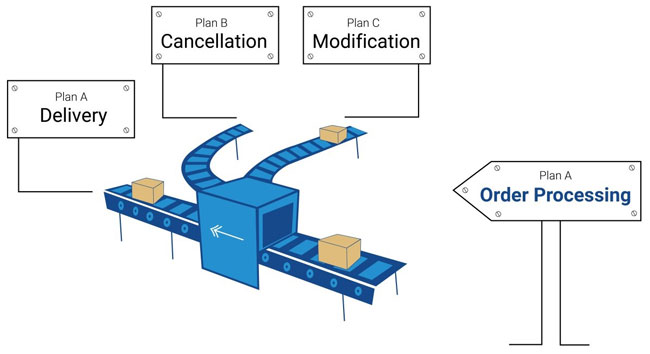How S/4HANA for Fashion and Vertical Business Overcomes Challenges in the Fashion Industry
07 April 2022


Richard Pascoe
Vice President - Consulting ServicesRichard Pascoe is the VP- Consulting Services, Applexus Technologies, UK. An experienced leader and business development manager, Richard has been accountable for the success of the...
With new trends and concepts emerging all the time, the fashion industry has a history of pushing boundaries. In the coming years, the fashion sector will see massive amounts of innovation with customer expectations shifting around interaction, shopping experience, and multiple touchpoints; introducing a new degree of complexity.
In this blog, we'll go over some of the key functionalities of SAP S/4HANA that address the major challenges faced by the fashion industry by helping companies transition easily to the future of fashion.
Seasonality
Seasonality is one of the major challenges faced by the fashion industry and forms an important part of the product life cycle. Winter, spring, summer, and autumn are no longer the only seasons with some fashion brands handling 12 or more seasons per year. Hence, transparency, ease of use, and efficiency are critical while navigating through seasonality.

To help fashion businesses overcome this challenge, SAP now provides Season Workbench to manage seasons. With this tool, they can define, change and delete seasons by year, season, collection and theme along with assigning articles to them. It also helps manage sales, purchasing, and production views for seasons.
Other key capabilities of the Season Workbench include automatic season determination during document creation, log verification with respect to each season determination, and capability to manually change seasons under unexpected events. Each season can then be applied to subsequent sales and purchasing papers, such as outbound or incoming delivery and billing documents.
Season Workbench thereby helps retailers to improve productivity by better aligning the products with the season and reducing inventory carrying costs.
Flexible Purchasing Commitments
Procurement efficiency is critical for fashion companies as they need to promise orders to suppliers at an early stage itself. However, communicating early on what/how much manufacturers should produce at an SKU level can prove to be a challenge due to the demand variation across multiple channels. Therefore, the ability to keep procurement commitments at a high level in advance is a key requirement for fashion companies as it provides them the flexibility to adapt to changing market requirements while maintaining good relations with suppliers.

SAP helps overcome this challenge through Flexible Purchase Commitment (FPC) that allows fashion companies to create purchase contracts with vendors, with only the generic article specified and the ability to provide variant specifications later. They also extend the ability to manage multi-level purchases by creating contracts regarding another purchase contract containing generic articles and variant specifications; allowing fashion companies to deploy supply anywhere based on demand in the global supply chain.
When it comes to pre-packs where fashion companies might not know the constituents of a pre-pack early on, the flexibility for higher-level purchasing commitments is necessary. SAP addresses this as well by providing flexible purchasing commitments even for structured articles (e.g. Prepacks).
Direct Ship Flexibility
Third-party order processing, in which the relation between sales orders and purchasing is locked from the beginning and modified later, frequently creates difficulty to resolve and is another source of concern for fashion companies. The direct ship flexibility sets linkage between sales and purchase orders as late as possible, even just before the goods leave from the vendor. It also allows for third-party order/purchase-to-order cancellation and quantity reduction along with de-linkage in case of a customer cancellation in a third-party order (TPO) item or an individual purchase order (PTO) item.

This removes the account assignment from the associated PO item and the stocks can then be diverted to any DC of the fashion company. In the case of quantity reduction, a new purchase order item is created with the difference in quantity that is not assigned to an account. The stock for the new purchase order item can then be diverted to any of the DCs of the fashion company or other customers.
Improving efficiency of TPO’s
One way to achieve more efficiency in third-party order processes is through better utilization of already existing purchase order items instead of creating new PO’s. The lead times can be significantly reduced as the existing purchase orders can be diverted directly to the customer from the factory within the requested date range. This is done by enabling third-party order/ purchase-to-order linkage alignment, wherein you assign an open account assigned purchase requisition (PR) to a freely available purchase order (PO) in the system.
Protecting Most Valued Customers
In the fashion industry, businesses usually deal with extensive lead times and uncertain consumer expectations, paired with a limited active season. As a result, supply shortages are quite prevalent. In supply shortage situations, supply assignment helps to decide how existing (and future) supply can be used most intelligently. It involves accurately aligning inventory demand with supply through optimizing open requirements and distributing the available supply by automated assignment criteria, ensuring customer satisfaction.

To improve the outcome, supply assignment and Back Order Processing (BOP) are combined into a single solution based on sophisticated ATP (Available-to-promise), and the demand is selected and sorted using a common framework. Product allocations, which are available in SAP S/4HANA, allow businesses to handle critical demand and procurement situations by designating goods in short supply to specified areas, customers, or shops for a set period. Using S/4 Fashion deployed with a fit to standard approach and advanced ATP, fashion companies can benefit from all future developments in advanced ATP.
Why S/4HANA for Vertically Integrated Fashion Businesses
Horizontal integration has always been the "go-to value chain strategy" by companies that wanted to grow their business at the same place inside the supply chain. The fashion industry, on the other hand, demands a highly flexible supply chain that considers both speed and cost. Vertical integration supply chains are the most efficient model to meet shifting demands in such scenarios.
Today, the most popular vertical integration solution for the fashion industry is SAP S/4HANA for Fashion and Vertical Business. SAP has envisioned it as a "full vertical integration" solution that has made real-time business accessible to fashion merchants. A single IT platform with a cross-channel integration layer to integrate all of a fashion retailer's channels, this solution gives businesses complete transparency and a consistent omnichannel customer experience.
This next-generation platform combines SAP HANA's lightning-fast analytics with transactions, allowing fashion businesses to collect and process data from wholesale, retail, and manufacturing while applying it to subsequent business processes in real-time.

Vertical integration through S/4HANA can also help businesses build powerful, flexible, and proactive supply chains that can satisfy changing consumer needs by enabling:
- Value chain management
- Cost-cutting in distribution
- Access to more production inputs, distribution resources, and processes
- Alignment with the latest fashion trends
Why Applexus for Your S/4 Fashion Journey?
Applexus has helped multiple fashion businesses transition seamlessly to SAP S/4HANA Fashion leveraging our deep SAP functional and technical knowledge combined with our unique RunWay and RunningStart approach to digital transformation. The Applexus Fashion Industry Focus solution and global delivery model ensure quicker ROI generation for our clients along with lower S/4 implementation costs.
One of our recent S/4 Fashion implementations helped the client realize significant benefits such as:
- Fastest completely remote S/4 implementation in just 8 months deploying S/4HANA, B/4HANA, and SAC
- Fit to standard approach with 85% reduction in custom developments
- Embedded analytics in key processes
- Automated the processing of 80% of invoices through InSITE, our vendor invoice management solution
Talk to our Experts
If you'd like to know more about how Applexus can help you in your SAP S/4HANA for Fashion and Vertical Business implementation,











